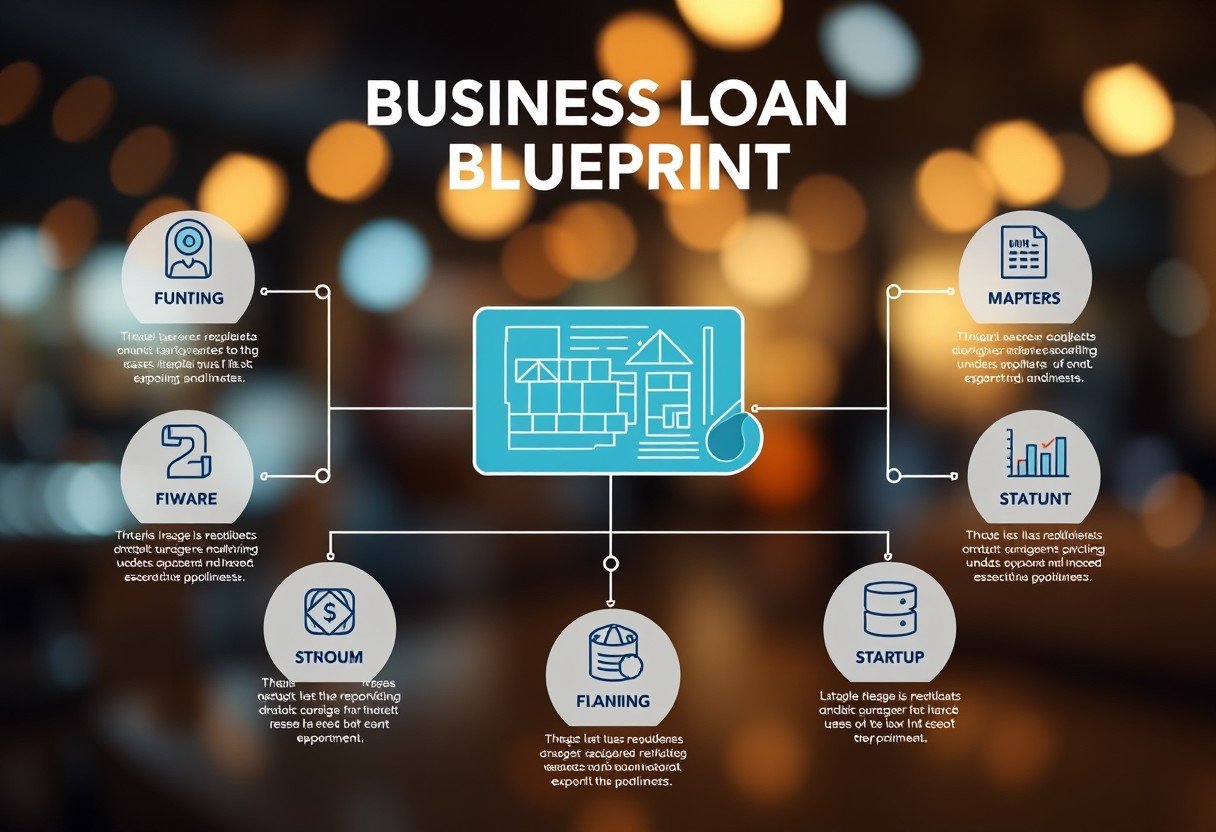You’re on the verge of launching your incredible startup, but without the right funding, your vision could stay just that—a vision. It’s time to put the pedal to the metal with this Business Loan Blueprint. In just 9 actionable steps, you’ll learn how to secure the cash flow you need to turn your dreams into reality. So buckle up, because mastering these steps could mean the difference between success and struggle. Let’s dive in and make sure you’re ready to seize your future!
Key Takeaways:
- Understanding Funding Options: Familiarize yourself with various types of business loans and funding sources available for startups.
- Building a Solid Business Plan: Create a comprehensive business plan that clearly outlines your vision, financial projections, and operational strategy to attract lenders.
- Preparing Financial Documentation: Gather necessary financial documents to demonstrate your business’s financial health and credibility to potential investors or banks.
Understanding Your Business Needs
Your path to funding starts with a clear understanding of what your business requires. This involves not just identifying how much money you need, but also the purpose behind that funding. Are you looking to launch a new product, expand your operations, or cover your day-to-day expenses? Getting clear on these points is crucial to ensure you are being strategic and not just guessing. Note, this isn’t just about numbers; it’s about vision.
Identifying Your Funding Goals
Goals are your roadmap. You need to outline specific objectives, whether that means hitting revenue targets, expanding into new markets, or investing in technology. Define what success looks like for you to bring clarity to your funding journey.
Calculating Your Financial Requirements
For many entrepreneurs, estimating the right financial needs can feel daunting. You must take a methodical approach, considering not just current expenses but also anticipated costs in the future. Think about one-time expenses versus ongoing operational costs; break down what it will take to not just survive but thrive.
Another critical step in calculating your financial requirements is to make sure you include a buffer for unexpected situations. Having a solid figure in mind isn’t just a fancy number; it’s how you protect your vision. You’ll want to think about the cost of production, marketing, and staffing, but also how to weather unforeseen challenges. This buffer can be a game-changer, ensuring that if things don’t go as planned, you’re not left scrambling. Don’t underestimate this; it’s the difference between thriving and surviving!
Building Your Business Plan
Some entrepreneurs underestimate the importance of a well-constructed business plan. Your business plan is your roadmap to success, and it’s absolutely important when it comes to securing funding for your startup. You want to create a clear, concise, and compelling plan that communicates your vision and strategy to investors. Let’s investigate the key components that will make your business plan compelling.
Crafting a Solid Executive Summary
With your executive summary, you want to grab attention from the get-go. This section should be a brief yet powerful overview of your business, encapsulating your mission, vision, and the problem you aim to solve. Make it succinct—it’s your chance to make a first impression, so don’t blow it!
Outlining Your Revenue Model
Executive summaries are just the tip of the iceberg; the revenue model outlines the way your startup plans to make money. You need to clearly define how you will generate income, whether it’s through sales, subscriptions, or services. Investors want to see that you’ve thought this through and have realistic projections.
This is the backbone of your business plan—without a solid revenue model, you’re importantly putting together a puzzle without cornerstone pieces. You should detail your pricing strategy, sales tactics, and potential partnerships. Imagine a world where you can just lay it all out: how many customers you need, what they’ll pay, and how long it takes to be profitable. This clarity will reek of confidence, and investors will take notice.
Detailing Market Research
Building your market research is a non-negotiable step in creating your business plan. You can’t expect to go to investors and say, “I have a great idea,” without backing it up with solid data. You need to understand your target audience, the market landscape, and your competition.
Solid market research demonstrates that you’re not just shooting in the dark; you’ve done your homework. Dive deep into the trends, customer preferences, and growth potential. Analyze your competitors—not just to know who they are, but to show investors how you will differentiate your business from theirs. Make it clear that you know your market inside and out, and you’re equipped to carve your niche. Investors love confidence backed by research, so make sure to bring your A-game here!

Exploring Funding Options
For many entrepreneurs, exploring funding options can feel overwhelming. With various avenues available, it’s crucial to understand each option before you dive in. Whether you’re seeking a traditional route or something more innovative, knowing your choices will empower you as you seek the capital needed to propel your startup.
Traditional Bank Loans
To secure a traditional bank loan, you’ll need a solid business plan, good credit, and possibly collateral. This route exposes you to lower interest rates and structured repayment plans, but it often comes with strict eligibility requirements that can hinder quick access to funds.
Alternative Lenders
The rise of alternative lenders has provided entrepreneurs with immediate access to funding. These lenders often have more lenient eligibility criteria compared to banks, allowing you to tap into capital quickly, but be cautious of higher interest rates and fees.
Traditional lenders tend to offer predictable terms and structured repayment schedules, but alternative lenders can be a lifesaver when you need funds fast. They include online lenders, peer-to-peer platforms, and fintech companies that leverage technology to streamline the borrowing process. Just remember; while their speed can be a huge advantage, do your homework and understand the total cost of borrowing before committing.
Crowdfunding Platforms
Lenders in the crowdfunding landscape provide a unique opportunity for you to connect directly with potential backers who believe in your vision. You present your business idea, and if people resonate with it, they can contribute financially in exchange for rewards or equity.
Another major perk of crowdfunding platforms is that they allow you to validate your business concept. It’s not just about raising money; it’s about building a community around your brand. However, ensure you’re ready for the hustle—promoting your campaign is crucial, and you may confront regressive fees or most importantly, a *public failure* if your campaign falls short of its goal.
Angel Investors
One of the most powerful funding avenues comes from angel investors. These individuals are often experienced entrepreneurs themselves and can offer not just capital but also invaluable mentorship to help your enterprise grow.
Plus, angel investors can become your strongest allies in scaling your business. They typically expect equity in exchange for their investment, but what you get is not just a check. You also obtain a passionate backer who is invested in your success, potentially opening doors to networks that can accelerate your growth. Just make sure you align your visions and values before taking them on as partners!
Preparing Your Loan Application
Now, let’s examine the nitty-gritty of preparing your loan application. This is where you lay the groundwork for your success. You need to go in armed with the right info and strategies to boost your chances of funding.
Compiling Necessary Documentation
Loan approvals hinge on thorough documentation. Gather your financial statements, tax returns, business plan, and any necessary legal documents. This paperwork acts as proof of your business’s viability and commitment, setting the stage for a solid pitch.
Enhancing Your Credit Profile
With your credit profile in check, you can significantly improve your chances of securing that loan. Monitor your credit score, pay down debts, and avoid any late payments. Every point matters; your credit score is a reflection of your financial responsibility!
Profile enhancement doesn’t have to be complicated. Start by checking your credit report for errors and dispute them. Build a solid payment history by settling bills on time and reducing your credit utilization ratio. Be mindful of, lenders see you through the lens of your credit profile; make sure it’s an impressive one!
Crafting a Compelling Pitch
On the next step, crafting a compelling pitch is crucial. You need to communicate your vision clearly and make it resonate with lenders. Your passion and determination should radiate through every word!
Enhancing your pitch involves more than just the facts and figures. Tell your story—explain why you started this business and what drives you. Showcase your expertise, market insights, and how your product or service solves a problem. Leave no doubt that you’ve got what it takes to thrive! Make them believe in you just as much as you believe in your startup.
To wrap up
To wrap up, the Business Loan Blueprint is your roadmap to securing that crucial funding for your startup. You’ve got the hustle, the vision, and now you’ve got the steps to make it happen. Don’t wait for the perfect moment; grab those resources, network like a beast, and execute your plan with relentless energy. Keep in mind, every successful entrepreneur was once just like you, chasing their dreams. So get out there and own your journey—let’s turn that business idea into a thriving reality!
FAQ
Q: What is the ‘Business Loan Blueprint’ and how can it help my startup?
A: The ‘Business Loan Blueprint – 9 Steps To Funding Your Startup’ is a comprehensive guide designed to assist entrepreneurs in securing funding for their new business ventures. It outlines a structured approach to obtaining a business loan, covering imperative steps such as assessing your funding needs, preparing your business plan, and presenting your case to lenders. By following this blueprint, you can increase your chances of obtaining financing tailored to your startup’s unique requirements.
Q: What are the 9 steps included in the Business Loan Blueprint?
A: The 9 steps in the Business Loan Blueprint include: 1) Evaluate Your Business Needs, 2) Create a Solid Business Plan, 3) Review Your Personal Credit, 4) Research Funding Options, 5) Prepare Financial Projections, 6) Gather Necessary Documentation, 7) Build a Strong Loan Proposal, 8) Approach Lenders, and 9) Negotiate Loan Terms. Each step is designed to guide you through the complex loan application process, ensuring you are well-prepared when seeking funding.
Q: Do I need a high credit score to qualify for a business loan?
A: While having a high credit score can improve your chances of securing a business loan, it is not the sole determining factor. Lenders consider various elements, including your overall business plan, revenue projections, industry experience, and collateral. The Business Loan Blueprint helps you understand the importance of each of these factors and how to strengthen your application, even if your credit score isn’t perfect.
Q: How does the Business Loan Blueprint address different funding sources?
A: The Business Loan Blueprint provides insights on various funding sources, including traditional bank loans, alternative lenders, grants, and crowdfunding options. It emphasizes the importance of researching multiple funding avenues to find the best fit for your business. The guide also explains how to tailor your loan proposal to align with the specific requirements of each funding source, maximizing your chances of approval.
Q: Is the Business Loan Blueprint suitable for all types of startups?
A: Yes, the Business Loan Blueprint is designed to be versatile and applicable to a wide range of startups across various industries. Whether you’re in the tech sector, retail, services, or any other field, the principles outlined in the blueprint can be adapted to suit your specific needs and circumstances. It serves as a foundational tool for entrepreneurs at any stage of their startup journey, from early ideation to market launch.

